
By R.W. Julian
If you own a Capped Bust half dollar dated between 1807 and 1836, there’s a good chance it was part of the Economite treasure. The Harmony Society, a separatist religious group, established a community in Economy, Pennsylvania, in 1824. While advocating unworldliness, they managed to achieve enormous commercial success in manufacturing and other enterprises. Members of the society held all their goods in common—and, apparently, in bulk. In 1836, part of the Harmonist fortune was sealed in a vault. When the stockpile of more than 118,000 silver coins was recovered in 1878, Capped Bust half dollars accounted for 111,356 of them.
Those who were around in the 1950s commonly used the half dollar—as frequently as they did the quarter dollar, in many parts of the United States. Today, the half dollar is virtually never seen in daily use, thanks to shortsighted government coinage policies.
The half dollar, long a mainstay of American commercial affairs, was first struck at the Philadelphia Mint in late November 1794. Coinage was heavy at first, especially in the opening months of 1795, because there was not a large enough coinage press at the Mint for silver dollars and depositors needed their silver coins.

Once coinage of dollars was able to begin in quantity, the number of half dollars being struck dropped off significantly. There was no coinage of this denomination at all in 1796, and in 1797 only a few thousand pieces were made, using dies of 1796 and 1797; these are among the most sought-after coins in the entire range of American numismatics.
Beginning in 1801, Mint Director Elias Boudinot, in order to reduce the number of silver dollars being sent abroad, persuaded some of the depositors to accept half dollars, instead. From this small beginning, Boudinot was able to have the coinage of dollars halted by March 1804. The silver coinage void would now be filled by the half dollar; many millions were coined over the next several decades.
One of the great myths of American numismatics concerns these early half dollars. Due to a misunderstanding that arose from research carried out in the late 1920s, many scholars came to the conclusion that early half dollars did not circulate and were used exclusively as bank reserves, in order to back up the widespread private paper currency. Nothing could be farther from the truth.
Sign Up for the FREE COINage Weekly Update!
Stay in the know. Get the latest news and information from COINage delivered
weekly – right to your inbox!
The early half dollars in the so-called Economite treasure included more than 100,000 Capped Bust half dollars, which were coined from 1807 to 1836. Even the rare 1815 date was present to the tune of more than 100 examples. The enterprising Harmony Society operated woolen and cotton mills, a grain mill, a wine press, a hotel, a post office, stores and farms in Economy. That the Harmonists could amass such a large collection shows quite well that such coins circulated widely.
It is, of course, true that half dollars were used as backing for the paper currency of that era, but a large proportion of them went directly into circulation—and stayed there. Even remote areas of the frontier, usually considered to have been shy of gold or silver, were well supplied with half dollars because Indian treaty payments were almost always made in this form. These coins were then spent with local merchants, putting them into widespread use.
Director Boudinot resigned his post in the summer of 1805 and was replaced by Robert Patterson, a college professor who was highly regarded in academic and scientific circles. At first, Patterson did little with respect to the coinage, but during 1806 he came to the conclusion that the designs on our gold, silver and copper coins ought to be changed as soon as possible. The idea was to reflect the new politics brought to the presidency by Thomas Jefferson.
John Reich, a German engraver of considerable talent, had come to America at the
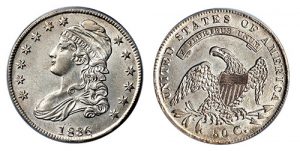
turn of the century, but it was some years before mint officials could persuade President Thomas Jefferson to add him to the engraving department. At length, in late March 1807, Jefferson relented and the stage was set for the creation of the famous Capped Bust half dollar.
In his letter of March 25, 1807, Director Patterson had asked that Reich be hired as assistant engraver at a salary of $600 per year, not a great deal more than common laborers made in those days. Patterson went on to note that, if Reich was hired, “the beauty of our coins would be greatly improved by his masterly hand.”
Patterson soon had Reich working on designs for the half dollar, which was considered the most important coin then being struck at the Mint; later the engraver would work on the other gold and silver coinage designs. By the fall of 1807, the Philadelphia Mint was striking the new Capped Bust half dollar from dies prepared by John Reich.
Little is known of the actual mechanism by which this particular design was chosen, but it can be assumed that Director Patterson oversaw every step of the work. There was a scurrilous rumor that continued to be repeated by mint officers until at length, in the 1860s, it was committed to paper in response to some long-forgotten question.
The writer of the memo reported that Reich had portrayed his “fat mistress” on the half dollar (and on the similar bust of Liberty for the other coins), a charge that might have been true, but more likely was not. Director Patterson almost certainly would have known the identity of any model who had posed for Reich in the guise of Liberty and would have been in position to reject unsuitable candidates. Considering that the Reich design of Liberty was supposed to represent America, it does seem very unlikely that Patterson would have accepted a mistress in that guise.
There was another rumor at the Mint in the 1850s that Reich had portrayed Director Patterson’s wife as Liberty, something that is slightly more credible, but almost as unlikely. Yet another rumor reported that the cent design of 1816—by Chief Engraver Robert Scot—used that same model; there clearly was considerable confusion by the 1850s over the models for the various designs.
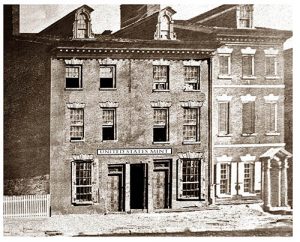
Whatever the source of the design, coinage of the new half dollars began toward the latter part of 1807. In 1860, Mint Director James Ross Snowden said that the changeover came in September 1807 and that 750,500 pieces were struck by the end of the year.
Unfortunately, Snowden’s figure was pure guesswork, and we do not know when coinage began. Snowden’s report for 1807, despite its flawed pedigree, will probably remain the accepted figure, however.
(The basic reference for the Capped Bust half dollar is the work by Al Overton, Early Half Dollar Die Varieties, 1794-1836. Several researchers are currently at work, however, on revisions of parts, and perhaps all, of the Overton book.)
One of the most interesting engraving errors came in the first year of coinage when, on the reverse, the numeral 20 was accidentally punched into a die instead of the correct 50. It was quickly redone, leaving only minor traces of the peculiar blunder.
Assistant engraver Reich created a slightly smaller Liberty head punch for the half dollar coinage that began early in 1809. There had been complaints from the chief coiner that the coins of 1807–1808 did not always strike up all that well and it took too much pressure for the results that were being obtained. The new head of Liberty was meant to take care of some of this problem.
In 1812, the hub was redesigned once more, perhaps because the Liberty head hub of 1809 had been used too heavily or was in some way rendered unfit for further use.
All of the Capped Bust half dollars from 1807 to 1836 had their edges lettered with the standard FIFTY CENTS OR HALF A DOLLAR but some experimental edges were tried out in 1809. These have ornaments, usually rendered as “XXXX” or “IIII,” between certain words; these command a certain premium over regular issues.
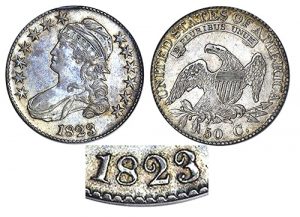
The experimental edges were contemplated by Mint officials because there was a continuing concern with counterfeits, although no such contemporary pieces are known at the present time. Collectors who deal only with the clad coinage of today tend to forget that intrinsic value was of great importance in 1807, when a half dollar meant payment for about six hours of work by the average unskilled laborer.
Strictly uncirculated and well-struck specimens of the early years (1807–1810) of the new design are rarely met with, and command large prices when offered for sale, either privately or at auction.
Throughout 1812, the supply of silver bullion was more than adequate, and large numbers of half dollars were struck. During 1813, however, the supply began to diminish, and by the middle of 1814, there were serious interruptions in the silver coinage because of these problems. Still, for the collector wanting a decent (Very Fine or better) specimen of the 1808-1814 half dollar coinage, there is little real problem.
By early in 1815, there was virtually no silver bullion in the Mint, and coinage of half dollars was interdicted. Toward the end of 1815, some bullion was deposited, and early in the New Year, 47,150 half dollars (all dated 1815) were struck. Most were paid out to Jones, Firth, and Co., a Philadelphia firm. The 1815 half dollar is actually an overdate, the obverse die having had its date recut from 1812.
The 1815 half dollar, which is the scarcest date of the Capped Bust type, commands a price in line with its rarity, even though there are several hundred coins of this date in the hands of collectors. In Extremely Fine condition this date is worth about $6,000.
Fire destroyed a portion of the Mint the day after the 1815 half dollars were delivered (Jan. 10, 1816), and it was not until 1817 that repairs and new machinery allowed silver coinage to resume. (Copper coinage had resumed almost immediately after the fire because the Mint was importing ready-made blanks from England.)
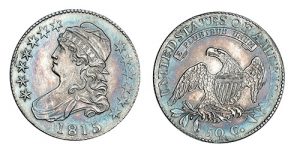
With the resumption of coinage in May 1817, half dollars were once more in plentiful supply; coinage continued at a very strong pace throughout the 1820s (although a depression in 1819 did hold down silver coinage in 1820). The 1820 half dollar brings higher prices, but the normal VF price for the period is usually under $200 if the collector does careful shopping among dealers.
One of the more interesting dates—not in terms of value, but rather varieties—is the 1823 half dollar. Over a century ago, collectors began coining names for the strange appearance of the 1823 date. One figure 3 was termed “ugly”, while another is sometimes called the “patchwork 3”.
These strange date variations for 1823, as well as various overdates that appear in the series (1824/1, 1808/7, 1819/8, etc.), are the natural results of the engraver doing all that he could to save money. New dies are expensive, and Engraver Robert Scot, who died in 1823, certainly did his best to keep every single die in service, no matter how blundered the resulting coin might appear.
Although most overdates in this series are relatively common, there is one special coin that has long drawn collector interest. This is the famous 1817/4 half dollar, which is so rare that newly found specimens rate stories in the weekly numismatic newspapers.
Regular proof coinage began at the Philadelphia Mint in 1817, but certain dates for half dollars are excessively rare. It is likely that less than a dozen proof half dollars were struck in any given year prior to 1837.
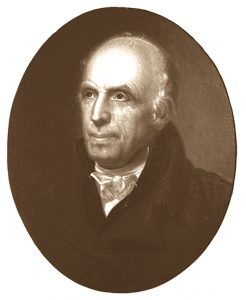
Half dollars dated after 1825—and continuing until 1836—become easier and easier for the collector to obtain. The collector can usually find a VF–20 specimen—certainly an acceptable grade for most collections—for under $150. Those of the 1830s are quite easy to find; for some of the later years, there may be more available specimens than collectors, leading to the low prices observed. This is not, of course, true for the earlier dates, especially 1815 and 1807.
The head of Liberty was slightly modified in 1834, though this has drawn little collector attention and has not changed values to any extent.
In 1836 came the end of the Capped Bust half dollar as we know it. The introduction of steam coinage presses in March 1836 doomed the old lettered-edge coins, and the dies were redesigned by Engraver Christian Gobrecht as soon as possible. The first of the new reeded-edge half dollars (which have a design similar to that in use in 1836) were struck in early November 1836, and then at the beginning of 1837, all such coinage was made with the reeded edge.
The final lettered-edge date, 1836, has a curious feature that has long intrigued numismatists who specialize in half dollars. To the right of the date, on some obverses, one finds a small bar, which some have seen as the remains of a figure 4. Others have proposed that this bar marks a special coinage of some kind and that the dies were prepared in this way so that the Mint officers could distinguish between mintages.
Oddly enough, there do exist lettered-edge Capped Bust half dollars of 1837 and certain later years, though the beginning collector would be well advised to stay clear of them; they are contemporary counterfeits made of German silver. At one time, these were considered of no value, but in the past few years specialists have begun to collect these pieces, and there are even good reference works for collectors.

Not too many years ago, collectors looked down on the half dollars of 1807-1836 because so many of the late dates were quite common; the same was also true for the Morgan dollar. Today, that situation is happily reversed, with many discerning collectors specializing in the interesting varieties that make up this series.













